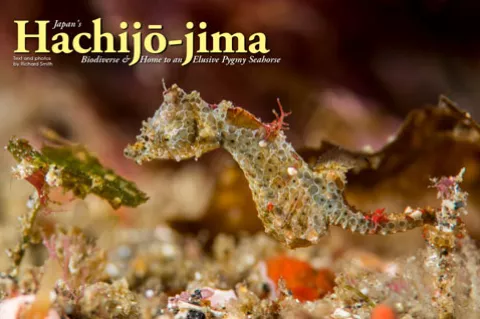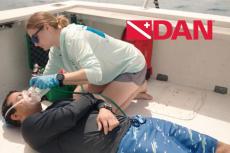Japan’s diving scene used to be a well-kept secret, but more and more people have realised that Japan has much more to offer than just sushi and karaoke. The country spans a vast latitudinal range, from the tropical south where coral reefs dominate around Okinawa and the other Ryukyu Islands, into the almost subarctic north. As a result, its biological diversity is great, with many different habitats accommodating a wide array of species.
Contributed by
Factfile
Dr Richard Smith is a British award-winning underwater photographer, author and marine conservationist who aspires to promote an appreciation for the ocean’s inhabitants and raise awareness of marine conservation issues through his images.
A marine biologist by training, Smith’s pioneering research on the biology and conservation of pygmy seahorses led to the first PhD on these enigmatic fishes. Smith is a member of the IUCN Seahorse, Pipefish and Seadragon Specialist Group. He has named the two most recent pygmy seahorse discoveries from Japan, Hippocampus japapigu, and South Africa, H. nalu.
Smith organises and leads marine life expeditions where the aim is for participants to get more from their diving and photography by learning about the marine environment. His bestselling book, The World Beneath: The Life and Times of Unknown Sea Creatures and Coral Reefs, is out now.
For more information, go to Instagram@Dr.RichardSmith, or Facebook@OceanRealmImages, Twitter@Rich_Underwater or visit: OceanRealmImages.com.
Japan’s diving has not historically been particularly accessible for foreigners, but over the past few years it has become much easier, and my return visits have shown me that it is certainly worth the effort.
Japan had been on my dive bucket list for many years, and when Okinawa was announced as the location for the quadrennial Indo-Pacific Fish Biologists Conference back in 2013, I jumped at the chance to attend. I was ostensibly in Japan to present some of my pygmy seahorse research at the conference, but my actual goal was to hunt for an elusive and undescribed pygmy seahorse. There are almost no images of these tiny fish and, like much of Japan’s marine life, it is hardly known outside the country. After months of online research (thank heavens for Google Translate) and detective work, I narrowed my search to Hachijō-jima.
Off the beaten path
After leaving the conference in the tropical south, I headed up to Hachijō, which scant few online images suggested to be a hotspot for these unnamed pygmy seahorses. Travelling around Japan is very easy. I hopped on a flight from Okinawa to Tokyo Haneda Airport, and then a 40-minute flight out to Hachijō. The island comprises a conjoined pair of ancient volcanoes, sitting 180mi (~290km) south of Tokyo. Although the Japanese pygmy seahorse was my main focus here, I soon ended up getting distracted by all sorts of other local species, many of which are found only in this area.
Japan’s territorial waters have eleven times as much ocean surface as land area. Its seas cover only 1.2 percent of the globe’s total ocean surface area but astonishingly harbour almost 15 percent of all described marine species. The island chain sprawls from the sub-boreal zone in the country’s far north, through cool temperate, middle temperate, warm temperate and subtropical, and finally reaching the tropical islands of the south. The wide variety of marine environments within these zones helps to explain some of its enormous variety of species. Amazingly, Japan boasts almost 2,000 marine species found nowhere else on Earth.
The reason that so many marine creatures in Japan are found nowhere else is thanks to the local oceanographic conditions. Just as the South Pacific Ocean Gyre pushes water across the Pacific in a counterclockwise motion, becoming the East Australian Current (the one which carried Nemo from the Great Barrier Reef down to Sydney), the North Pacific Gyre, as the Kuroshio Current, pushes water from the Equator northwards to Japan.
This current is the Pacific’s largest. It has a significant impact on marine ecosystems, bringing with it warm water and tropical fishes where you might not expect them. This northerly flow also has the effect of creating a barrier to fishes trying to move southwards. The current acts as a wall to their southerly migrations and, as a result, they are effectively isolated in Japanese waters, much like the giant tortoises, marine iguanas and Darwin’s finches of the Galapagos. In isolation, they have evolved into unique forms, and many endemic marine species exist in Japanese waters. Hachijō’s waters are heavily influenced by the Kuroshio Current and boast a plethora of rare and indigenous species, so my wish list of animals had grown to be quite extensive by the time my plane touched down.
Hachijō-jima
I had planned to dive with the wonderful Kotaro-san from Concolor Diving, and would also be diving with my friend and long-time dive buddy, Katsuko. As an accomplished photographer, Katsuko has been diving in Southeast Asia for many years, but she had never dived in the waters of her own country. Kotaro has a great dive operation located in the low-growth forest of the smaller of the two volcanoes, which was where we would meet each morning. A couple of small buildings offered a gear store, compressors, hot showers and changing area as well as a relaxing salon with tables where one could sit and download images between dives. We stayed at a local full-board hotel around the corner, so things really could not have been easier.
Exploring the seas
Despite there being many shore dives around the island, whenever possible, we dived the site Nazumado, which is generally only possible over the summer months. On a subsequent trip, however, we also chartered a local fishing boat occasionally.
Kotaro is particularly passionate about the diversity of Hachijō’s marine life. He has a well-stocked library, but I learnt just as much from speaking with him. He showed me the beautiful wrought-iron butterflyfish, which is found only around a few of Japan’s offshore islands and is especially abundant around Hachijō. We also saw the Hubbard’s hawkfish, another rare regional endemic.
There were also several unexpected tropical discoveries, including a pair of harlequin shrimps, several boxer crabs, stunning bubble snails, and striped boarfish in several deeper caves. These latter fish have a wide geographic range but are found at only a few scattered locations around the Pacific. They are large disc-shaped fish with a wonderful bristly beard under the chin.
Entry at Nazumado can be a little hairy; hence, access to the site is limited to just a few summer months or days with particularly good weather. My visits have been in May and June, generally before cyclone season and when the waters tend to be calmer and the chill has been taken out of them. The currents that bathe the island are, however, unpredictable and temperatures can vary from day to day between the high teens to mid-twenties Celsius.
On my first dive, Kotaro tasked himself with fulfilling my wish of observing the Japanese pygmy seahorse, and within ten minutes of entering the water, he had found a pair on the side of a huge algae-covered boulder at about 11m depth. They were actually quite large for pygmies, at around 2cm in length, but resembled the tropical Pontoh’s species in habit. Like Pontoh’s, the Japanese pygmy is also free-living, but has a unique reticulated pattern over the body that in my mind distinguished it from other pygmies I had seen before. Over the next few days, I found a dozen more of these special little fish. It gave me the impression they were fairly common here, but when I returned a few years later with some friends, we saw just one individual despite searching for many dives.
Since then, along with Japanese, American and Australian colleagues from the International Union for Conservation of Nature (IUCN) Seahorse, Pipefish and Seadragon Specialist Group, we have scientifically described this unusual new pygmy seahorse as Hippocampus japapigu. “Japapigu” is the name given locally to these fish, and it seemed fitting to name them as such.
The actual naming took a few years, as it was not until 2017 that I met Graham Short, a leading seahorse taxonomist. I was giving the keynote speech about seahorse and pipefish diversity at a seahorse biologist’s conference in Florida. During my talk, I mentioned this pygmy seahorse and that I was sure it was a new species. After that, Graham and I made it our mission to name it, and in 2018 the new species was officially described. Just this year, we also named another new pygmy from South Africa—the first known from the Indian Ocean. It appears that the oceans have many more secrets to reveal when it comes to these small fishes.
Many surprises
Other fishes of note during our dives were Japanese swallow angelfish, blue-stripe angelfish, dragon morays, and, one of my favourites, the hilarious “Mohican” tube blenny. Of these fishes, only the Japanese swallow angelfish is restricted in its geographic range, but many of these other species are unusually common in Japan compared to the rest of their wider range. The geographic range of dragon morays, for example, spans from east Africa to Hawaii, but despite several thousand dives looking, Japan is the only place I have ever seen one.
It is not only small fishes that Hachijō is known for. Although I did not see them myself, the deeper areas are frequented by thresher and hammerhead sharks, offering an alternative to the smaller creatures of the reef. I went on a morning dive to hang out at the place the threshers are commonly seen. There was only myself and two guides, who both saw the shark, but I was all distracted daydreaming about pygmies and managed to miss it! The area also gets regular sightings of hammerheads if you go to the right spot, but currents can be quite strong in these areas.
When conditions are less forgiving, there are some large man-made harbours that offer great diving too. Entry is via protected slipways and the life within these bays is quite different to the exposed sites. Here, we saw more nudibranchs, several stunning bubble snails, and fishes such as blennies that we had not seen outside the bays. There is a mix of algae and hardy coral, making for an interesting substrate to hunt for critters.
Inside a somewhat open embayment, we also did a “Hot Ke Night” dive, where Kotaro set large lamps to attract passing plankton and larval fish, much like a blackwater dive. I am generally not too excited about floating around in the black abyss for a dive, so this made for a great compromise and was rather fruitful.
On the last day of the trip, Kotaro kindly offered to take us on an adventure around the island. The island has been inhabited for many centuries, and we saw some of the first buildings. There were also free onsen (hot spring) footbaths looking over the ocean at one spot around the other side of the island. One night, Kotaro also took us out looking for glowing mushrooms. I had never heard of such a thing, but it was incredible to see the two-inch-high mushrooms glowing bright green on the dark forest floor. These land-based activities are definitely worth exploring on any non-diving days.
Mission complete
Despite visiting several locations during my multiple trips to dive in Japan, I have only scratched the surface of what it has to offer the adventurous diver. Even Hachijō offers a different complement of animals at different times of the year, and I will definitely be back. Many other areas around the country also have great diving with various endemics that remain high on my list. In fact, I had planned to return in 2020, which sadly wasn’t to be, but I certainly plan to return in the not-too-distant future. ■
Japan National Tourism Organization (JNTO) has launched a site called “Japan Diving” to welcome divers from all over the world. You can choose from a menu of over 170 dive locations in Japan. For further information about diving in Japan via JNTO, please visit: japan.travel/diving/en/.





































